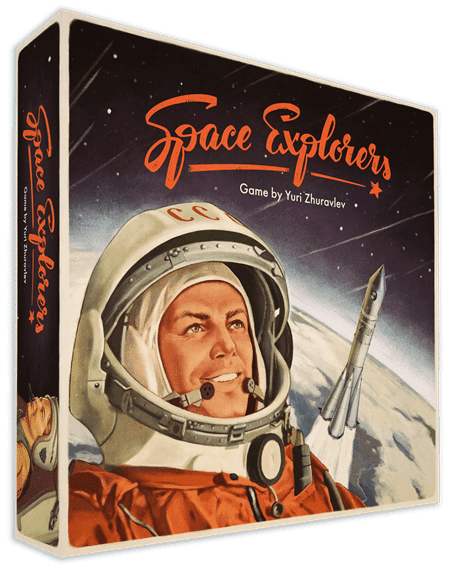Space Exploration and vintage 1960s style art? I’m in!
But really, what more do you want?
Oh… more info about the game? Well, I’ve known Chad Elkins of 25th Century Games through social media for about a year now. You may have seen his work recently in the form of Christmas Lights, which should be hitting tables at homes across the world in a couple months! When I saw he had a new project that was a space-themed tableau builder, I was immediately intrigued! Space Explorers is designed by a Russian gentleman by the name of Yuri Zhuravlev.
The best thing about Space Explorers is you don’t have to be a rocket scientist to play!
As far as components, there are 60 Specialist cards, 10 project tiles, and 20 research tokens. Very straightforward. You also get a Hub board (not L. Ron, though) and reference sheet to help keep you organized while playing. Learning the game takes less than 10 minutes. Teaching the game takes less than 5.
For a 2-player game, it should take you roughly 20-30 minutes your first time through, and then depending on how thinky you or your opponent is, the time will either shorten due to familiarity or lengthen due to over-thinking.
The game fits into what I like to call, “The Perfect Balance”. Other games that fall into this category for me are Splendor, Fantastic Factories, Century: Spice Road, and so on. The premise is easy to understand, the component count is low, the learning/teaching time is low, but the strategy is very high.
One thing that’s a LITTLE wonky to grasp initially is the SKILLS versus RECRUITMENT COST. My main piece of advice is to pay attention to the SHAPE of the icon you are looking at, to figure out what purpose it serves. The circular icons are SKILLS and the square icons are the RECRUITMENT COST (and the RESEARCH TOKENS used to pay for them). It “feels” like the SKILLS pay for the RECRUITMENT COST, but they do not, they simply mitigate the costs. Here is a quick How to Play video, as well!
I highly recommend this game to anyone who likes: space, strategy, games that take less than an hour but scratch the “challenge” itch, space exploration, strategic thinking, Russia, America, Space Force, NASA, engineering, science… you get the point.
Here is a mid-game example of my Hub. I have 1 Engineer (blue), 1 Tester (green), 1 Scientist (yellow), 2 Builders (red), and 1 Astronaut (purple). The game ends when a player has 12 Specialists or all of the Projects (satellites/spaceship/interplanetary station) have been built.
The art is also super fun. For each type of Specialist there is only 1 illustration, and rather than complicating the game with a lot of art, they simply zoom in on the more powerful versions of each Specialist type. As you can see above, the green Specialist is zoomed quite close up (they are worth 3 VP, cost 5 and have an ability) while the blue Specialist is zoomed out (they are 0 VP, cost 2, and has a less potent ability).
One cool thing is that if (when) they fund in the first 48 hours EVERY backer will receive a cloth mission patch like the ones NASA used to make!

Space Explorers is a tableau building game for 2-4 players, ages 12+, and plays in about 20-40 mins. It is designed by Yuri Zhuravljov, best known for designing Viceroy, and is illustrated by Alexey Kot.
Players are the head of their own Research and Development Hub in a Space Research Center. Your goal is to gather the best and brightest minds humanity has to offer, and complete large scale space projects.
Space Explorers features 20 different historical spacecrafts, 10 American and 10 Soviet, covering satellites, manned spaceships, and orbital stations. A wide range of spacecrafts can be found in the game from the Golden Age of Astronautics including Sputnik and Apollo 11.
As Soviet Cosmonaut Yuri Gagarin said aboard the Vostok 1 on April 12, 1961, as he was positioned on the launchpad poised to be the first human in space…“Let’s Go!”About







